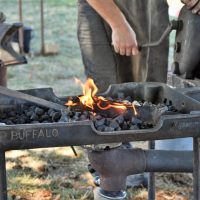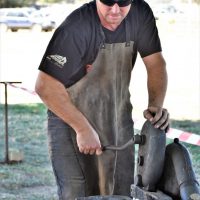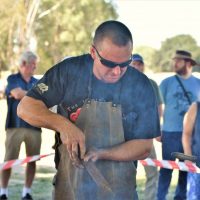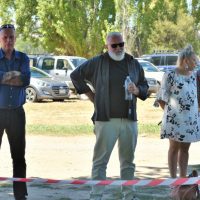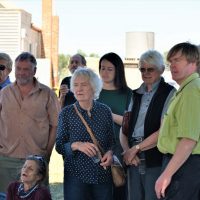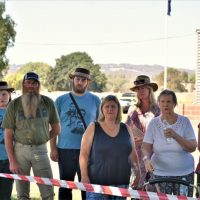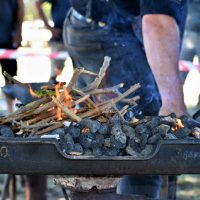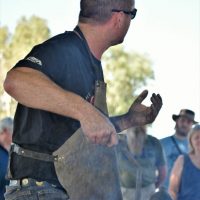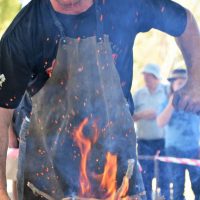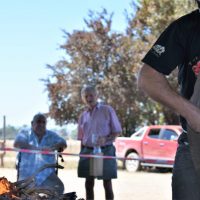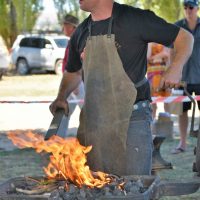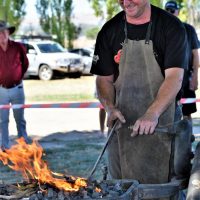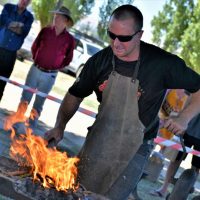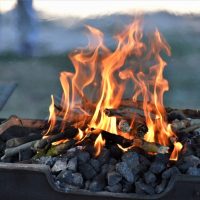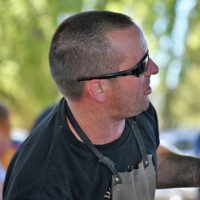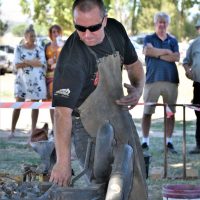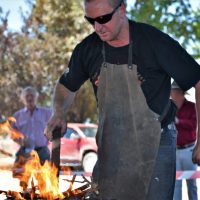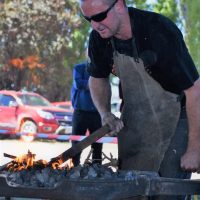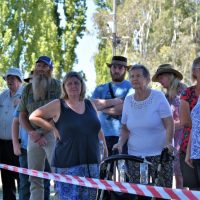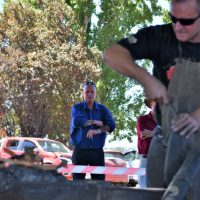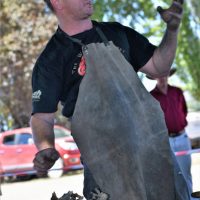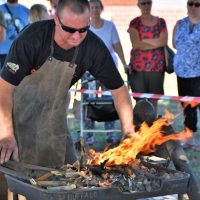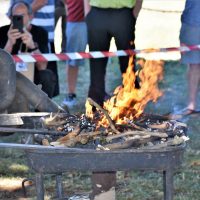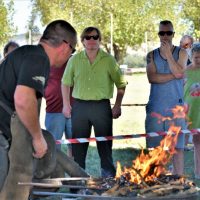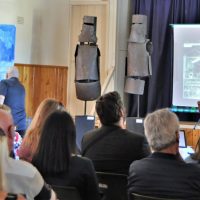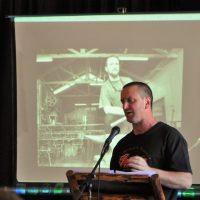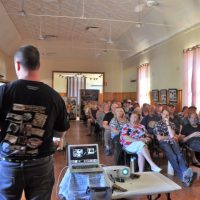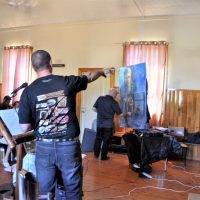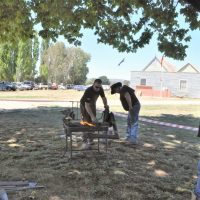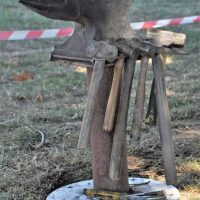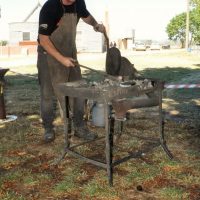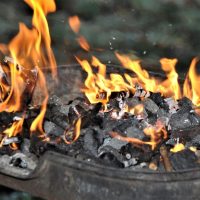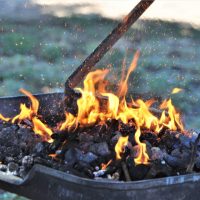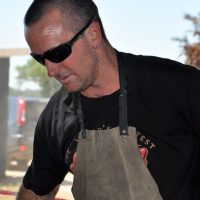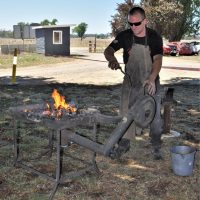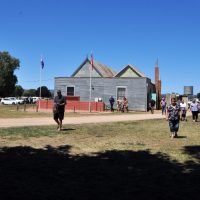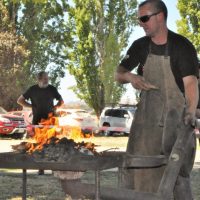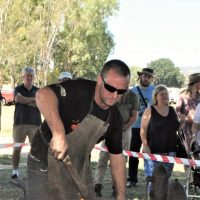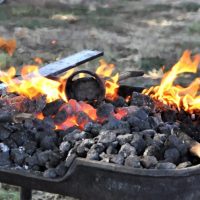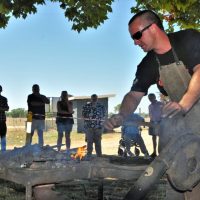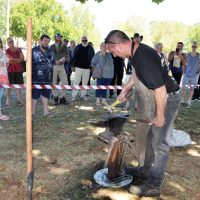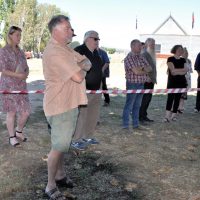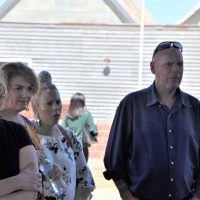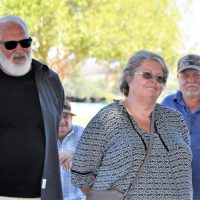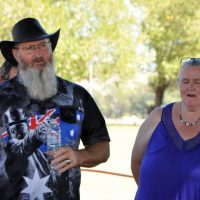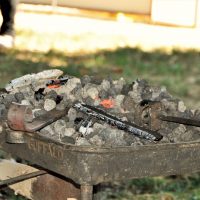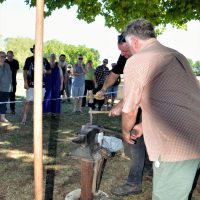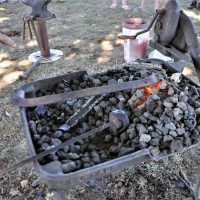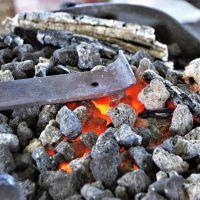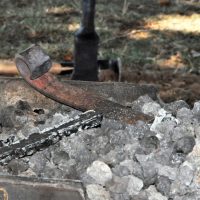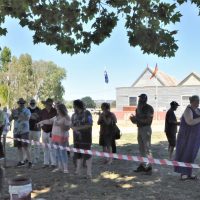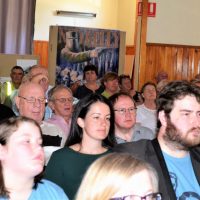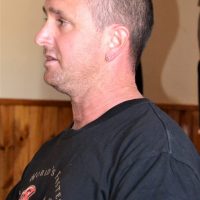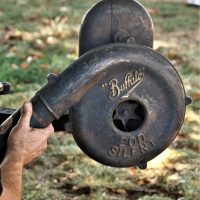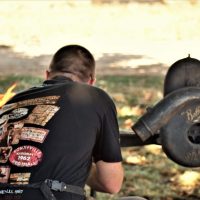Forging the Kelly Gang Armour
Nick Hawtin
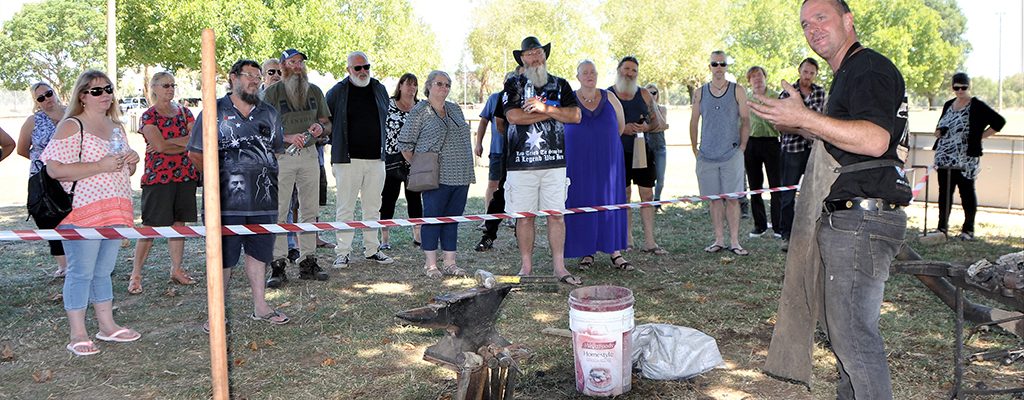
proprietor of the award winning blacksmith shop: Rutherglen Forge and Anvil
The Armour: the myths, the facts… was held on Saturday 23 February 2019 at the Greta Hansonville Hall. Discussions focused on the Kelly Gang’s armour – how it was made, why it was made, and the impact it has had on history, folklore, and popular culture. One of the presenters was well-known blacksmith Nick Hawtin who spoke about making the armour and then gave a demonstration on smithing. Nick owned the famous Rutherglen Forge and has produced some well crafted pieces including replica armours for the Jerilderie Shire (made to the exact weight and size of the originals).
Greetings and thank you for attending this function in Greta, located near the birthplace of not only one of Australia\’s most interesting designs, but one of its most influential engineering ideas. I was fortunate over my career as a blacksmith to have been featured in several television shows such as Dr Harry\’s Practice and, probably the most important to everyone here, the ABC Catalyst episode where they tested Joe Byrne’s armour. That episode concentrated on the myth and theory of the how the armours came to be made. Today, I will explain my findings and thoughts on how the armours where made. I may not be one hundred percent correct but I will share with you what I have experienced over the years as a smithy and the difficulties and thoughts while making these armours.
Catalyst gave me much insight into my own thoughts on how these armours came into being and the science answered several burning questions. These armours to me are a symbol of futuristic manufacturing genius. To be involved in a shootout with the Kelly Gang, where so much shrapnel and bullets were exchanged, would have been an unbelievable scenario to the police. So much so that they would have been forced to re-evaluate their standard plan for a siege.
Over the years the main question on everyone’s mind was, and still is, who created the armour and where was it made? Even after today’s discussion the mystery will continue. When I was commissioned by the Jerilderie Shire to manufacture the Gang’s four sets of armour I spent many hours researching the styles and types of armours made. Visiting the Melbourne exhibitions and museums, the Benalla fibreglass copy, and also viewing some amazingly detailed insurance images of Steve Hart’s armour. I also researched drawings made over the years, all of which gave me enough insight and inspiration to attempt my reconstructions.
Being able to view, wear, and hold Joe’s helmet was a significant moment in my quest to make a faithful replica. Being able to see and feel the hammer marks and lines in the metal forms granted me a deeper understanding of how the components were manufactured.
I must admit it still took me several prototypes to get my head around how the armour would have been produced. It was so tempting to take the easy path of using modern equipment with the advantages of plate rollers, drills, grinders, and oxyacetylene cutting. Being a solo smithy I tend to blend modern day skills and tools with traditional principals of the charcoal forge with a motorised air blast. The air blast forces the fire to burn hotter and the metal to achieve higher temperatures making it easier to form, punch, fire weld, and cut.
Reflecting back on the Catalyst episode and the discussion around the cold forming of the metal where the temperature range, during the manufacturing of cherry red heat, is around 450 to 550 degree celsius. The Gang’s armour experienced some cold bending, and some heats of a longer period (up to 750 degrees celsius). Fire welding, however, would have to be above 1100 degree celsius. Therefore, I suggest the longer heats were forge related. By making the armour by hand I learnt a lot about what skills and methods they would have used to achieved these brilliant pieces of metallic art.
The armours, as all enthusiasts know, were made from worn mould boards. These where of a higher carbon content than the wrought iron and our everyday modern day steel. They were abrasion and wear resistant against the rocky land they cultivated. Being worn down plates they had various thickness ranges from 6mm down to 3mm (in old terms 1/4 to 1/16th of an inch) plate which can be seen upon closer inspection when viewing them on display. These differences in thickness would have made the steel easy to work with as less heat would need to be applied, allowing for sections to be cold formed. When you heat metal it expands the carbon molecules and allows it to be formed easier. If you let the metal cool naturally the grain structure will return close to its original form. But if you quench it in oil or water it will lock the carbon to the outer area of the metal’s skin causing a case hardening effect.
So was the armour blacksmith made or was it created over a green tree branch in Greta somewhere by the Gang? It seems everyone has an opinion. I base my findings on my own learned experiences with building armour replicas and what has been referenced in books.
I feel that we have lost the ‘how and where’ the armour was made along the way in retelling the story of Ned Kelly. It’s been overlooked. Making the armour wasn’t as captivating to the narrative and it became misplaced among the more exciting tales of Stringybark, the hold-ups, the siege, and Ned’s trial.
My theory on how the armour was made is a little bit of both – blacksmith shop and green tree. You may disagree but let me put forward my reasons. If you take a look at the iconic helmet worn by Ned you can clearly see the radius of the mould board and the hot chisel cut eye section (in the form of an ‘L’). There are also pre-chiseled holes around the top of the helmet that held the leather strapping for the skull cap to rest upon. There is also a large punched hole for the front bib. If you look closer at the original back radius, which turned the soil, it has the top section of the eye socket bolted through.
From my experience this could not be achieved on a green tree branch and bush fire forge. Firstly the mould board would need to be flattened out and the original curvature removed. This would require temperatures well above 550 degrees celsius along with large heats to avoid the chill factor when removing the metal from the forge. To hot cut the steel you would need a temperature above 750 degrees celsius along with a solid surface to cut upon – namely an anvil table or a hardy chisel point. You would also require a striker (assistant) to hit the hot chisel while the smithy held the armour piece and maybe another tool. It is near impossible to do this on your own.
Ned’s bib has bent sections level through the middle countersunk hole which was a bolt hole for attaching to the plough. This could be obtained by holding a leg vice and striking the curved sections or over the edge of an anvil and the beak. Old bolts hold the bib to the head piece probably a reversed countersunk plough bolt or originally a rivet.
When you look at the bib it would be impossible to keep the formation of the flat section without clamping or by striking it over a flat surface. You can see the fatigued metal where it has been struck and, in some areas due to not enough heat, small cracks. Hammer marks can be clearly seen within the unevenness of the side curvature of the bib.
The chest plate on Ned’s armour comprises two worn mould boards hot riveted together through pre-chiseled holes. Again, this would have been achieved by large heat and heavy punching through the pre-chiseled hole on the anvil. Then hot rivets taken from the forge by the smithy and struck by the striker. The expanded metal rivet would shrink when cooled and clamp the two pieces of metal together tight.
The leather shoulder strap holes punched and cut would require the same process. Pre-chiseled at either ends of the slot then hot chisel cut for the slot straights. All actions only achievable on true blacksmithing tools of the trade. The front arm cut-outs again would be hot cut and, judging by the marks on the folded edges, it would have been done over the table of the anvil. You can see the imbedded lines where the edges have been formed over a solid edge, namely an anvil table. Looking at the back plate they would have hot cut and split the top shoulder sections. Again, it could only have been achieved in a smithy shop.
So what did a blacksmith shop circa 1879 look like? You need to discard all preconceived thoughts as to what you believe that smithy shop to be. Unlike the movies, most blacksmith shops back then had large anvils, great bellow forges, water cooled tips, etc. Generally your town smithy was the go-to man for shoeing if you were unable to do these things yourself. The smithy did repairs, wheelwrighting, and general metal forging. Most smithing was practical and not always decorative. The majority of decorative forging was spent on ornate hinges for church doors and so forth. Most smithy shops evolved into mechanical shops as they went from blacksmiths to wheelwrights, then onto repairing the motorised wagons. Some progressed into metal welding and fabrication. Everything back then was large – streamlining hadn’t been introduced.
It would have been a logistical nightmare to move large anvils and bellows to a remote location. Most anvils weighed in excess of 200kgs – not something you could easily relocate. The forges were lined with fire clay and would have broken if you moved them. It was only in later years that the smithy became more versatile. Thanks to the automobile the smithy could pack light and travel to sites carrying small anvils and portable forges. Let’s not forget most farms had their own blacksmith shop that catered for everyday needs such sharpening implements, and general repairs. These self taught smithies forged on the farm, produced their own charcoal, and shoed their own horses. Usually, larger jobs (such as wheelwrights, etc.) would have been taken into town.
I could easily go into detail on the way each Gang member’s armour was built, but I have already covered most of the principles and concepts. I would, however, like to discuss the different styles of armours. I say with confidence that not all armours where made by the same smithy. There are too many different styles to come from the one blacksmith shop. There are different ways of doing things to achieve the same result. Looking at Joe Byrne’s armour you see it is the only fully enclosed suit with side plates bolted – attaching the front and rear pieces to form a body suit.
His armour would have to have been lifted onto Joe, or he would have had to devise a clever method of dressing in it. The helmet has very small eye slots and is a totally different looking piece when compared to Ned’s. Just to curl over the edges on Joe\’s eye slot would have taken some extensive heat and a sharp flat edge (to start the curl-over) which would have been created on the anvil table and its edge.
Steve Hart\’s armour to me looks like it was either made by the apprentice blacksmith or was built from the remains of what was left over after completing the other three suits. Its functionality in theory was useable but it lacked major style and had design faults such as a huge eye socket that left him vulnerable to head shots. Being the youngest of the Gang it was possible he was forgotten until the last moment and then they pieced it together.
However, Dan Kelly’s armour is an amazing set which somewhat confused later custodians as it was photographed with what they said was the double riveted breast plate but, if you look closely, the shoulder plates would hinder forward arm movement. Therefore, that beautiful double rivet plate was in fact his back plate. In my opinion, based on style of smithing, I believe Ned and Dan’s armour was made by the same smithy with assistance of the gang or his striker. This is based on the same style of riveting, helmet, and body suit formations.
Joe and Steve\’s armour was definitely made by different smithies. When you factor in the days to design the concepts, source the mould boards, produce the armour, and then test its strength these projects would have to have run concurrently. And I haven’t forgotten the green tree branch and bush forge near a creek at Greta.
I believe this also did happen. Why? Because while the technical sections and heavy forging work was done in a smithy’s shop or farm forge, the Gang finessing, adjusting, and final assembly was done at another location, either a smaller farm or possibly bush forge, far from any spying eyes, using a green branch to better form the radiuses and a creek for quenching (allowing the steel to surface harden). As the armour was near fully constructed it would require a body of water, like a creek, to be quenched. A simple farm forge cooling tub would be hard pressed to accommodate the extra size.
To summarise, the sets were primarily made over a blacksmith forge and anvil and the final tweaking, during fit and assembly, was completed in a farm or bush forge. I have yet to read any eye-witness account of the armours being created. With the Gang already under the watchful eye of the law, carrying freshly made armour sets out of a local community blacksmith\’s shop would have created unwanted attention. So secrecy and timing was the key. Smuggling pieces out to a location for finishing and assembly would have been plausible. Getting caught with a full constructed helmet would have led to more than a few raised eyebrows.
The heat from a coal fire, without bellows, would have been enough at 400 to 550 degree celsius to allow the boys to make the final adjustments but with no true smithing work. This touches on the remote location and suppression of noise theory. A green tree branch would certainly have absorbed most of the shock and noise, but a farm based forge may also have played an undocumented role in the assembly, finishing, riveting, and maybe even the whole process. Uninterrupted and close to a water source they could have quenched the armour pieces after each adjustment. Some people claim the boys used the water to dull the noise. I tend to disagree with the ‘water to suppress noise’ theory as the sound would have resonated across the surface.
The Catalyst results showed some high range and low range temperatures. Unfortunately, the armours were not checked for staining or leeching (of eucalyptus sap) from the green branch – if a bush forge was used there would be some residue left as it tried to burn the green timber. Possibly the majority of Steve Hart\’s armour was created in the bush as they may have forgotten him, judging by the look of his suit.
Back in Ned’s day the smithy shop was raw, practical, and functional. Not all the mould boards would have been stolen, some would have been donated by sympathisers. More still may have just been lying around as nothing was thrown out and everything was recycled. Even a farmer with smithing experience could have completed some of these tasks. But with the count of four gang members, two boards per helmet, a minimum of four boards per suit, plus extra for the lappets there would need to have been at least thirty mould boards sourced. Not one blacksmith shop would carry all of this which gives reason to the theory there were more than one smithy involved along with additional locations. We have spent over one hundred years talking about the Kelly Gang armour – who made it, and where it was made. The ABC’s Catalyst story gave us new insight into theories and ideas as to the armour’s composition but the discussion on how the actual creative process was undertaken, during such a volatile period in Victoria’s northeast, is just getting beginning…
Link: Kelly Gang Armour: The Myths, The Facts by Noeleen Lloyd

